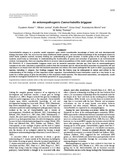An entomopathogenic Caenorhabditis briggsae

View/
Date
2010Author
Abebe, E
Jumba, M
Bonner, K
Gray, V
Morris, K
Thomas, WK
Type
ArticleLanguage
enMetadata
Show full item recordAbstract
Caenorhabditis elegans is a premier model organism upon which considerable knowledge of basic cell and developmental biology has been built. Yet, as is true for many traditional model systems, we have limited knowledge of the ecological context in which these systems evolved, severely limiting our understanding of gene function. A better grasp of the ecology of model systems would help us immensely in understanding the functionality of genes and evolution of genomes in an environmental context. Consequently, there are ongoing efforts to uncover natural populations of this model system globally. Here, we describe the discovery of a Caenorhabditis briggsae strain and its bacterial associate (Serratia sp.) that form an entomopathogenic complex in the wild. Laboratory experiments confirm that this nematode and its natural bacterial associate can penetrate, kill and reproduce in an insect host and that the bacterial associate can induce this insect pathogenic life cycle in other Caenorhabditis species, including C. elegans. Our findings suggest that this life history may be widespread in nature and critical to the understanding of the biology of this important model organism. Caenorhabditis–insect interaction could be a key factor in our quest for a better grasp of gene functionality in this important model species. The discovered association, consequently, would provide an ecological framework for functional genomics of Caenorhabditis.
URI
http://jeb.biologists.org/content/213/18/3223.shorthttp://erepository.uonbi.ac.ke:8080/xmlui/handle/123456789/36851
Citation
J Exp Biol 213, 3223-3229.Subject
insect parasitenematode
symbiosis
nematode–bacterial association
African Caenorhabditis briggsae
